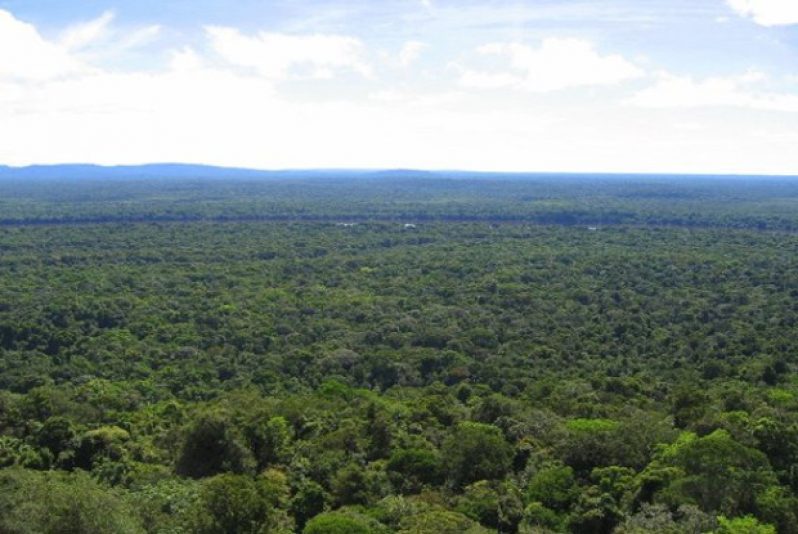LEVERAGING the benefits of their pristine rainforests for profits on the carbon credit market together is a possibility being explored by continental neighbours, Guyana and Suriname. With over 87 per cent forest cover, Guyana, according to the Rainforest Foundation, is one of the most heavily forested countries in South America. The same could be said of Suriname, which, according to REDD+, has forest cover of over 93 per cent.
This mass of greenery, aside from its natural beauty and role as a home for both nations’ wide biodiversity, serves as one of the major tools in the combat against climate change. “We recognise that we share similar conditions and opportunities as it relates to the environment and climate change,” President, Dr. Irfaan Ali, said during a joint press conference with the visiting Surinamese President, Chandrikapersad Santokhi, at the Arthur Chung Conference Centre, on Thursday. Considering the fact that both nations have had good credentials in the area of environmental preservation, the plan, ahead of the United Nations Climate Change Conference, also known as COP26, is to develop a common strategy for management of the environment and countering climate change.
To this end, he said: “We are going to jointly approach the area of environment and climate change to come up with a common strategy for both Guyana and Suriname ahead of COP26… and in exploring the possibility of merging forest assets in the carbon credit market.”
Carbon credits are considered market mechanisms for the minimisation of greenhouse gases emissions.
To advance discussions on the existing possibility of benefitting collectively from the carbon credit market, Vice-President, Bharrat Jagdeo, will be leading a delegation to Suriname before COP26. The Vice-President will be tasked with coordinating Guyana’s strategy and working with Surinamese authorities to develop a common strategy to deal with climate change and the environment.
On Guyana’s end, there are already plans to reintroduce the Low Carbon Development Strategy (LCDS).
AVOIDED DEFORESTATION
This strategy is premised on the concept of avoided deforestation, which allows Guyana’s 15 million hectares of rainforest to serve as a carbon sink, a process that is critical to combating global climate change. Deforestation accounts for about 20 per cent of human-generated greenhouse emissions.
To support the LCDS, the Governments of Guyana and Norway had agreed on a ground-breaking model where Norway will pay US$250 million towards Guyana’s forest climate services between 2010 and 2015. This is the second largest deal of its kind in the world.
It was reported that the government has already started to re-engage the European nation on this area of support.
Not just the re-engagement of Norway, but also the discussions between Suriname and Guyana are timely since the Inter-governmental Panel on Climate Change (IPCC), in its most recent statement, said: “Many of the changes observed in the climate are unprecedented in thousands, if not hundreds of thousands of years, and some of the changes already set in motion, such as continued sea level rise, are irreversible over hundreds to thousands of years. However, strong and sustained reductions in emissions of carbon dioxide (CO2) and other greenhouse gases would limit climate change.”
When asked how Guyana plans to balance the preservation of its environment with the operations of its burgeoning oil and gas sector in light of the IPCC’s report, President Ali said: “There is a gap as to when the targets will be realised… there are many targets that were set for climate change and money that the developed world set aside for climate change that we did not receive yet but there is a new pledge for new money.
OUTMATCH ANYONE
“Our credentials on the environment outmatch anyone, so we can say in a net way, we are a positive story on the environment side.”
For this reason, he believes that there is room for Guyana to capitalise on the benefits of its petroleum sector and still be able to maintain its credentials in the area of environmental preservation. Speaking along the same line during the Offshore Technology Conference (OTC), Vice-President Jagdeo said: “Because there is this Climate Change imperative to decarbonise, our policy is to get as much oil out of the ground as quickly as possible. It sounds a bit harsh for those who think you should be environmentally sound but that is the reality of it. “We have to maximise the benefit from the industry and use those benefits to change our people’s lives… We don’t know how swiftly we’ll get to a decarbonised world but we have to make use of this period when there is still demand to get as much as possible out of the ground and that is why we support the rapid pace of the industry but it must be done safely.”




.png)









